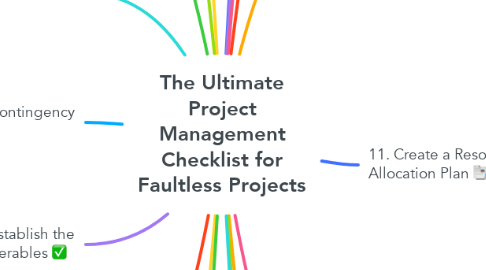The Ultimate Project Management Checklist for Faultless Projects
Door Ade Omomo-Rashed


1. 6. Create a Vision 🖼
1.1. From the smaller goals, create a wider vision statement. Without a strong, shared vision, it’s hard to gather the momentum needed to get the project off the ground. The vision statement should explain what the project is hoping to achieve in a few details: Where does the project fit with the overall business strategy? What will be the project’s outcome? How will the project benefit the stakeholders?
2. 7. □ Develop the Budget 💵
2.1. A project budget is a detailed, time-based estimate of all the costs for your project. You typically develop a budget in phases – from an initial estimate to a detailed version to the final approved project budget. When starting a project, it is difficult to know how much it will eventually cost – and with so much uncertainty in projects, it can be one of the project manager’s greatest challenges. Your project budget will be made up of different direct and indirect costs, with a small amount assigned for contingency reserve. Once you have an idea how long a project is going to take and how many resources you need (coming right up in the checklist!), you can calculate the approximate total for the direct and indirect costs.
3. 8. Determine the cost
3.1. Determine the Direct Costs These costs are directly attributed to the project and charged on an item-by-item basis. Labour (people) costs Consultant fees Raw material costs Software licences Travel costs
4. 9. Determine the Indirect Costs
4.1. These costs signify resources that benefit more than one project, and only a proportion of their total cost is charged to the project. Telephone charges Office space rent Office equipment costs General administration costs Company insurance costs
5. 10. Add the Contingency Reserve
5.1. Add the Contingency Reserve Don’t forget to reserve a buffer to your project to cover risks – the contingency reserve. Usually, it’s a percentage of the total project cost and time.
6. 12. Establish the Deliverables ✅
6.1. Using the previously defined goals, create a list of things the project needs to deliver to meet those goals. Simply put – tasks and subtasks. Specify when and how to deliver each item. Add notes to tasks that might seem confusing or need an explanation. It never hurts to add detail!
7. 15. (Re-)Assess the Deadline ⚙️
7.1. A common problem discovered at this point is that you have an imposed delivery deadline from the client, that, based on your estimates, is unrealistic. If you discover that you can’t deliver the project in time, you must contact the client immediately. The options you have: Renegotiate the deadline (project delay) Employ additional resources (increased cost) Reduce the scope of the project (fewer deliverables) Use the previously created project schedule to justify pursuing one of these options.
8. 17. Create a Risk Management Plan ⛔️
8.1. Although often overlooked, risk management is an important part of project management. It is important to identify as many risks to your project as possible and be prepared if something bad happens. Here are some examples of common project risks: Unclear roles and responsibilities Poor communication resulting in misunderstandings, quality problems and rework Stakeholders adding or changing requirements after the project has started Lack of resource commitment Misunderstanding stakeholder needs No stakeholder input obtained Too optimistic time and cost estimates Remember: Ignoring risks doesn’t make them go away 😉
9. 19. Format 📇
9.1. Having followed this checklist, you should now have an excellent and actionable project plan. Now it’s time to match the content with appearance. Include the project information such as the client & project name Add your company’s (and the client’s) logo Use your company’s branded fonts and colour scheme
10. 1.Research 🗂
10.1. Before taking on a project, you have to stop and make sure you know all the facts. Take a deep breath and dive into the project documentation, ask thoughtful questions, be informed and methodical.
11. 2. Understand Your Role 🎩
11.1. Having a clear understanding of your role is an important pillar of a successful project. Even if it isn’t documented on paper, it will help you ensure that all stakeholders are considered and that you’re aware of your responsibilities in case issues arise.
12. 3. Identify the Stakeholders 🕵️
12.1. A project is successful when it has met the expectations of all stakeholders. A stakeholder can be anybody directly or indirectly impacted by the project. It is not always easy to determine the project’s stakeholders, particularly those affected indirectly
12.2. The client The project manager The project team Consultants The customer who receives the deliverables
13. 4. Write a Project Plan ✍️
13.1. Now you’ve gathered enough information to start planning the project. Use whatever project planning tool that works for you, be it Trello, Scoro, or even a simple spreadsheet. Some tools are more comprehensive than others, but a rock solid project plan can be achieved in any solution as long as it helps you to formalize your thoughts and keep consistency.
14. 5. □ Set Goals 🚀
14.1. The first step in creating any project plan is setting achievable goals. Meet with the stakeholders, and discuss the possible outcomes. Turn the output into a comprehensive list, and prioritize the needs. A good technique for doing this is reviewing them against the SMART principle.
14.2. Remember: Every goal has to be measurable. Depending on your project’s objectives, you can track various Key Performance Indicators (KPIs). Monitoring KPIs helps to evaluate the project’s performance and make data-driven decisions.
14.2.1. https://www.scoro.com/blog/16-essential-project-kpis/
